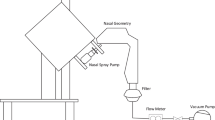Abstract
Purpose. The objective of this study was to investigate the effect ofnasal cavity patency on the penetration, deposition, and clearance ofan aqueous isotonic saline solution.
Methods. The study was carried out as a single center, open,randomized, 2-way cross-over in healthy volunteers. Nasal patency wasassessed using misting patterns on a cold metal surface at the beginningand end of study. 100 μl of technetium-99m radiolabeled saline solutionwas introduced into either the most or least patent nasal cavity usinga purpose designed spray device. The distribution and residence timeof the radiolabel was followed for 2 hours using gamma scintigraphy.
Results. The mean times to 50% clearance were34 ± 7 and 28 ± 12minutes (±s.d.) for the side view of the least and most patent nasalcavity respectively. Total clearance of the radiolabelled saline from thenose was not affected by patency. Between 7 and 3% of theradiolabelled saline solution remained in the nasal cavity at the end of imaging.Using endoscopy to track the clearance of an aqueous solution of fooddye using the same delivery procedure, identified this region as hairin the nasal vestibule. The dye was seen to dry in this region alongwith the mucus.
Conclusions. Nasal patency affects the initial, but not total clearanceof solutions, however, the remaining solution may not be available fordrug delivery.
Similar content being viewed by others
REFERENCES
V. J. Lund. Nasal physiology: neurochemical receptors, nasal cycle and ciliary action. Allergy Asthma Proc 17:179–184 (1996).
R. Kayser. Die exacte Messung der Luftdurchgängikeit der Nase. Arch. Laryngol. 3:101–210 (1895).
B. Singh and G. S. Chinna. Some reflections on ancient Indian physiology. In: Keswani, NH, Manchanda, SK (eds). The Science of Medicine and Physiological Concepts in Ancient and Mediaeval Indis. 26th International Congress of Physiological Sciences, 1974.
H. Hallen, C. Geisler, A. Haeggstrom, and P. Graf. Variations in congestion of the nasal mucosa in man. Clin. Otolaryngol. Appl. Sci. 21:396–9 (1996).
P. Cole. The respiratory role of the upper airways. Mosby-Year Book, St Louis, MO 1–59 1993.
P. Cole. Physiology of the nose and paranasal sinuses. Crit. Rev. Allergy Immunol. 16:25–54 (1998).
J. S. J. Haight and P. Cole. Unilateral nasal resistance and asymmetrical body pressures. J. Otolaryngol. 91:1–31 (1970).
F. Bojsen-Moller and J. Fahrenkrug. Cyclic changes in the air passage of the rat and rabbit nose. J. Anat. 110:25–37 (1971).
L. A. Damani. Metabolism of drugs in the respiratory tract. Rubinstein M. (ed) In Pharmaceutical Technology: Controlled Release. Ellis Horwood, Chichester 1987 pp. 47–52.
J. J. Principato and J. M. Ozenberger. Cyclical changes in nasal resistance. Arch. Orolaryngol. 91:71–77 (1970).
D. F. Proctor. The muciliary system. Proctor D. F. and Anderson, I. (eds) In: The Nose: Upper Airway Physiology and the Atmospheric Environment. Elsevier Biomedical, Amsterdam, 1982.
J. J. Homer and C. H. Raine. An endoscopic photographic comparison of nasal drug delivery by aqueous spray. Clin. Otolaryngol. 23:560–563 (1998).
Author information
Authors and Affiliations
Rights and permissions
About this article
Cite this article
Washington, N., McGlashan, J.A., Jackson, S.J. et al. The Effect of Nasal Patency on the Clearance of Radiolabeled Saline in Healthy Volunteers. Pharm Res 17, 733–736 (2000). https://doi.org/10.1023/A:1007590501540
Issue Date:
DOI: https://doi.org/10.1023/A:1007590501540




